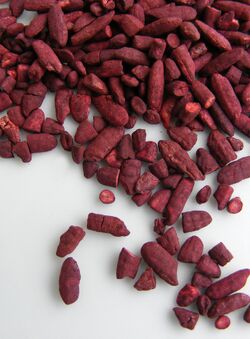Biology:Monascus purpureus
| Monascus purpureus | |
|---|---|

| |
| Monascus purpureus growing on white rice (red yeast rice) | |
| Scientific classification | |
| Kingdom: | |
| Division: | |
| Class: | |
| Order: | |
| Family: | |
| Genus: | |
| Species: | M. purpureus
|
| Binomial name | |
| Monascus purpureus (Went, 1895)
| |
Monascus purpureus (syn. M. albidus, M. anka, M. araneosus, M. major, M. rubiginosus, and M. vini; simplified Chinese: 红曲霉; traditional Chinese: 紅麴黴; pinyin: hóng qū méi, lit. "red yeast") is a species of mold that is purplish-red in color. It is also known by the names ang-khak rice mold, corn silage mold, maize silage mold, and rice kernel discoloration.
Taxonomy and morphology
The sexual state of M. purpureus is a cleistothecium with a two-layered wall enclosing round, evanescent 8-spored asci, lifted above the substrate on a multihyphal stalk. Ascospores can be heat resistant. The asexual state forms chains of hyaline or brownish chlamydospore-like cells.
Physiology and metabolites
During growth, Monascus spp. break down starch substrate into several metabolites, including pigments produced as secondary metabolites. The structure of pigments depends on type of substrate and other specific factors during culture, such as pH, temperature, and moisture content.[1]
However, discoveries of cholesterol-lowering statins produced by the mold has prompted research into its possible medical uses. It produces a number of statins. The naturally occurring lovastatins and analogs are called monacolins K, L, J, and also occur in their hydroxyl acid forms along with dehydroxymonacolin and compactin (mevastatin). The prescription drug lovastatin, identical to monacolin K, is the principal statin produced by M. purpureus. Only the open-ring (hydroxy acid) form is pharmacologically active, but it is not produced on a commercial scale.[2][3][4][5]
The mycotoxin citrinin is carefully monitored when Monascus is used in fermented foods. Industrial use of soluble red pigments as food dyes was discontinued in the US and Europe because of this risk.[6]
Importance
Monascus purpureus has been used for over a thousand years in oriental fermented foods, including red kōji-kin, red yeast rice or ank-kak, rice wine, kaoliang brandy, and as the coloring agent for Peking duck.
Commercial species
The related fungi M. ruber and M. pilosus are also used in industrial applications.[7] Monascus ruber is also a common food spoilage organism; most strains produce a brown pigment.[8]
See also
References
- ↑ Chiang Mai Journal of Science
- ↑ Endo A (2004). "The origin of the statins. 2004". Atheroscler Suppl 5 (3): 125–130. doi:10.1016/j.atherosclerosissup.2004.08.033. PMID 15531285.
- ↑ "Statins in hypercholesterolaemia: a dose-specific meta-analysis of lipid changes in randomised, double blind trials". BMC Fam Pract 4: 18. 2003. doi:10.1186/1471-2296-4-18. PMID 14969594.
- ↑ "Simvastatin vs therapeutic lifestyle changes and supplements: randomized primary prevention trial". Mayo Clin. Proc. 83 (7): 758–764. 2008. doi:10.4065/83.7.758. PMID 18613992.
- ↑ Duggan, Mark; Hartman, George D (15 August 1989). "Novel HMG-CoA reductase inhibitors". http://patft.uspto.gov/netacgi/nph-Parser?Sect1=PTO2&Sect2=HITOFF&u=%2Fnetahtml%2FPTO%2Fsearch-adv.htm&r=11188&f=G&l=50&d=PTXT&s1=lovastatin&p=224&OS=lovastatin&RS=lovastatin.
- ↑ Chen, YP; Tseng, CP; Chien, IL; Wang, WY; Liaw, LL; Yuan, GF (2008). "Exploring the distribution of citrinin biosynthesis related genes among Monascus species.". Journal of Agricultural and Food Chemistry 56 (24): 11767–11772. doi:10.1021/jf802371b. PMID 19012408.
- ↑ "Production of Angkak Through Co-Culture of Monascus purpureus and Monacus ruber.". Braz J Microbiol 41 (3): 757–64. 2010. doi:10.1590/S1517-83822010000300028. PMID 24031553.
- ↑ Samson, Robert A.; Reenen-Hoekstra, Ellen S. van. (1988). Introduction to food-borne fungi (3rd ed.). Baarn: Centraalbureau voor Schimmelcultures, Institute of the Royal Netherlands Academy of Arts and Sciences. ISBN 978-9070351168. OCLC 18574153.
- Bibhu Prasad Panda, Saleem Javed, Mohd. Ali (2010) Optimization of fermentation parameters for higher lovastatin production in red mold rice through co-culture of Monascus purpureus and Monascus ruber. Food and Bioprocess Technology, Vol. 3, no.3, 373-378 doi:10.1007%2Fs11947-008-0072-z
- Mazzanti G, Moro PA, Raschi E, Da Cas R, Menniti-Ippolito F. Adverse reactions to dietary supplements containing red yeast rice: assessment of cases from the Italian surveillance. British Journal of Clinical Pharmacology 2017; 83(4): 894–908. doi:10.1111/bcp.13171, PMC 5346868, PMID 28093797
External links
- Index Fungorum page (synonyms)
- Index Fungorum page (general)
- Monascus purpureus page
- Website about medicinal use of Monascus purpureus
Wikidata ☰ Q15401777 entry
 |

